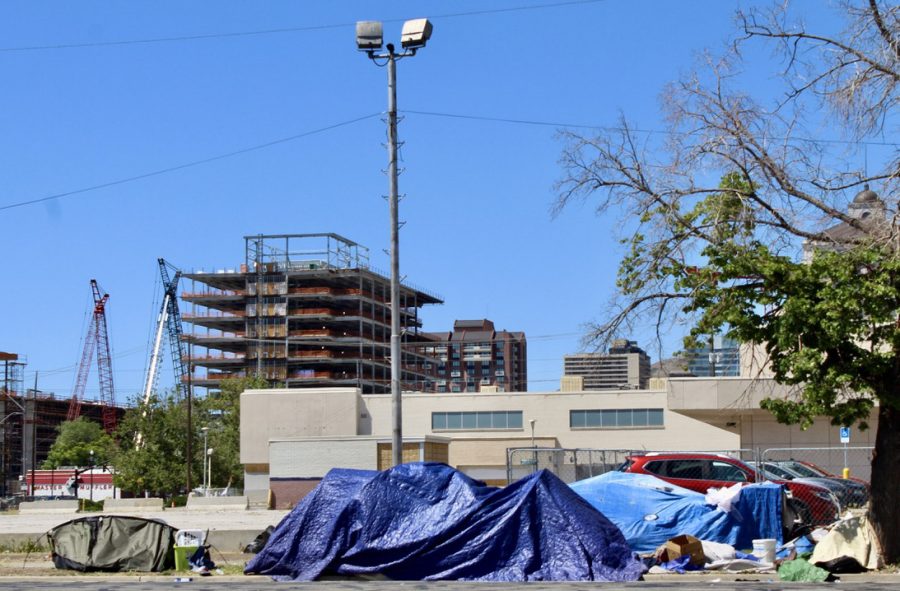Lezaic: Hostile Architecture is Inhumane
A tent city built by the homeless in Salt Lake City on Sunday, May 30, 2021. (Photo by Brooklyn Critchley | The Daily Utah Chronicle)
April 17, 2022
As we leave behind cold weather and gear up for another scorching summer, we cannot forget about our unsheltered neighbors. In addition to extreme weather conditions, our negligence forces unsheltered folks to deal with cruel architectural designs.
When it rains and they seek roofs to sleep under, cities and private businesses install spikes on the ground to chase them away. When cities notice unsheltered people sleeping on public benches or patches of grass, they are quick to add unnecessary armrests and replace the grass with unwelcoming rocks. This happened near a women’s homeless shelter here. The train stations planted along the University of Utah’s campus have seat dividers, which is unsurprising considering the importance of public transportation to the unsheltered community.
These design choices that intentionally create barriers for unsheltered people are examples of hostile architecture. This architecture is inhumane and denounces the existence of our unsheltered neighbors.
Hostile architecture is defined by the Cambridge dictionary as “the design of public spaces in a way that stops unwanted behavior.” Though hostile architecture affects many groups (disabled, fat, pregnant and elderly people), the main target is the unsheltered community. Anti-loitering signs and encampment sweeps make it clear that our unsheltered neighbors are unwanted in the public eye.
Hostile architecture is not just limited to spikes and signs. Often, it appears in the form of impractically shaped public seating that prevents people from sleeping there — benches at an incline or with random seat dividers jutting out of them. Many are posed as artsy experimentation, but there is nothing tasteful about the hidden agenda of these structures.
Sleeping is not a crime. Existing is not a crime either. No matter how much private landowners try to rebrand existence as “loitering,” unhoused people should be able to exist and take up space. Hostile architecture forces the unsheltered population further out of sight, and by extension, out of mind. We become desensitized to this issue and feel entitled to their absence for our selfish peace of mind.
This desensitization makes it easier for us to look away from the 117 unsheltered people who died in Utah last year — doubling the deaths of the prior year. It allows us to ignore the city’s traumatizing encampment sweeps that force unsheltered people out of their homes and communities. We turn our heads as their belongings are destroyed and their efforts uprooted.
These encampments are often located on the outskirts of our cities, but it seems that nowhere is far enough for city officials and business owners. Rather than helping these folks survive, they invest their money in structures to push them even further away from the public eye. But public spaces are, as the name indicates, for everyone — not just those deemed worthy of existing.
But as we see both the dangers of climate change and the increasing homelessness rates, public areas are dwindling and hostile architecture is on the rise. This hostility also manifests as an intentional lack of shelter. Public spaces that offer protection from the environment can be the difference between life and death.
Last summer, we had the hottest months ever recorded in Salt Lake City. And our summers have been getting hotter, sooner. Our state also saw several flash floods that destroyed hundreds of homes. Most notably, Salt Lake City had the worst air quality in the world last summer when smoke from the west coast’s wildfires rapidly drifted in. City officials warned those with sensitive health conditions to stay inside at the time, but this sentiment did not extend to our unhoused neighbors.
The unhoused population has felt our government’s carelessness with COVID-19 acutely, and when paired with the detrimental impacts of wildfire smoke, the outcome was deadly. Unless something changes, these types of events will likely happen again this summer, and every summer after that.
Our government not only makes public spaces uncomfortable during these times but removes them. The decrease in public spaces is allegedly due to COVID-19 social distancing measures. However, when our government fails to provide shelter for unhoused people to social distance within, they should at least have access to areas such as public parks to protect themselves from the elements.
Gentrification also plays a large role in the popularization of hostile architecture. As developers take over low-income areas to make space for pricy condos, the new residents are more likely to call the cops on unsheltered people. This entitlement to a guilt-free wealthy environment is part of the vicious cycle fed into by things like hostile architecture.
As students at the U, where many of us are white, middle class, and younger adults — the very groups that gentrify neighborhoods — we need to assess our role in gentrification and take action against it.
This includes joining groups like Wasatch Tenants United which organize “to alleviate housing insecurity, unfair living conditions, and rising living costs across the Salt Lake Valley.” Additionally, groups such as Open Air Shelter work to support our unsheltered neighbors and collaborate with them to fight for systemic change. Another great group is Just Media Utah, which keeps a tab on such issues by calling out our local government officials and instances of hostile architecture.
Inhumane architecture and abuse of our unsheltered neighbors must stop. We also must go beyond mere toleration of the unhoused community and work on creating a society that doesn’t abandon its people. The path to this future is community engagement and activism for housing justice.








